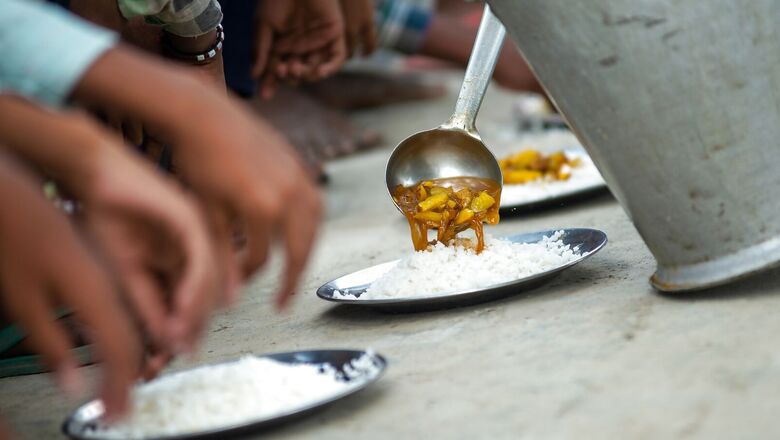
views
Among India’s most serious yet marginally addressed development challenges is malnutrition, which contributes significantly to the country’s disease burden. Despite programme commitments since 1975, such as creating Integrated Child Development Services (ICDS) and national coverage of the mid-day meal scheme, India continues to grapple with a high rate of undernutrition. Improving nutrition and managing stunting continue to be big challenges, and they can be addressed only with an inter-sectoral strategy.
Stunting has lifelong consequences on human capital, poverty and equity. It leads to less potential in education and fewer professional opportunities. According to the National Family Health Survey (NFHS)-5, India has unacceptably high levels of stunting, despite marginal improvement over the years. In 2019-21, 35.5 per cent of children below five years were stunted and 32.1 per cent were underweight. India ranks 116 out of 174 countries on the human capital index. Lack of investment in health and education leads to slower economic growth. The World Bank says, “A 1 per cent loss in adult height due to childhood stunting is associated with a 1.4 per cent loss in economic productivity.” Stunting also has lasting effects on future generations. Further, with 57 per cent of women anaemic in 2019-21, this will have lasting effects on their future pregnancies and children. The situation worsens when infants are fed inadequate diets.
Ambitious Goals
The Poshan Abhiyaan 2018 aimed to achieve a malnutrition-free India by 2022. The plan is to reduce stunting prevalence in children (0-3 years) by about three percentage points per year by 2022 from NFHS-4 levels, and achieve a one-third reduction in anaemia in children, adolescents and women of reproductive age.
This is an ambitious goal, especially given that the decline in stunting from 48 per cent in 2006 to 35.5 per cent in 2019-21 comes to only one percentage point a year. This promise calls for serious alignment among ministries, convergence of nutrition programmes, and stringent monitoring of the progress made in achieving these goals.
The data available on stunting tell us where to concentrate future programmes. Stunting prevalence tends to increase with age and peaks at 18-23 months. Timely nutritional interventions of breastfeeding, age-appropriate complementary feeding, full immunisation, and Vitamin A supplementation have proven effective in improving outcomes in children. However, NHFS data shows that only 41.8 per cent children are breastfed within one hour of birth, 63.7 per cent are exclusively breastfed for six months, 45.9 per cent are provided timely complementary foods, and only 11.3 per cent children below two years receive an adequate diet. The data confirms that the complementary feeding practices being followed are poor and need urgent attention.
It is well recognised that most of the growth faltering occurs during this critical period, from six months to two years, when complementary feeding plays a significant role in addressing nutrition intake by a child. It is evident that adoption of appropriate complementary feeding practices requires behavioural changes with reference to making informed selection of appropriate food items and following recommended feeding practices. Vitamin A deficiency can increase infections like measles and diarrhoeal diseases. About 30 per cent of children don’t get full immunisation and Vitamin A supplementation. They must be provided these for disease prevention.
Variations across States and Districts
According to NFHS-5 data, India has more stunted children in rural areas (37.3 per cent) as compared to urban centres (30.1 per cent), possibly due to the low socio-economic status of households in rural areas. The inter-generational cycle of malnutrition has to be tackled with effective interventions for both mother (pre- and post-pregnancy) and child, to address the high burden of stunting.
In terms of geographical regions, Meghalaya (46.5 per cent), Bihar (42.9 per cent), Uttar Pradesh (39.7 per cent) and Jharkhand (39.6 per cent) have very high rates of stunting, while states/UT with the lowest rates include Sikkim and Puducherry at 22.3 per cent and 20 per cent, respectively. A comparison of NFHS-4 with NFHS-5 findings shows that few states (Madhya Pradesh, Uttar Pradesh and Uttarakhand) have reported decline in stunting by at least 6 percentage points, Rajasthan has recorded a decline by 7.3 per cent.
While nutrition has improved across all states, inter-state variabilities remain high. The two states that had the lowest stunting rates in children in 2015-16 (NFHS-4) but showed a substantial rise in stunting rate as per the NFHS-5 survey are Goa (from 20.1 per cent to 25.8 per cent) and Kerala (from 19.7 per cent to 23.4 per cent).
Looking at this data, it is imperative to push for convergence of health and nutrition programmes right from pregnancy until the child reaches five years of age. A well-planned and effective social behavioural and communication (SBCC) strategy is essential since behaviours are ingrained in society and in family traditions. What is really needed is effective monitoring and implementation of programmes to address malnutrition and prioritising the reduction of child undernutrition in the national development agenda.
Dr Shoba Suri is a Senior Fellow with ORF’s Health Initiative. She is a nutritionist with experience in community and clinical research. The views expressed in this article are those of the author and do not represent the stand of this publication.
Read all the Latest Opinions here

















Comments
0 comment